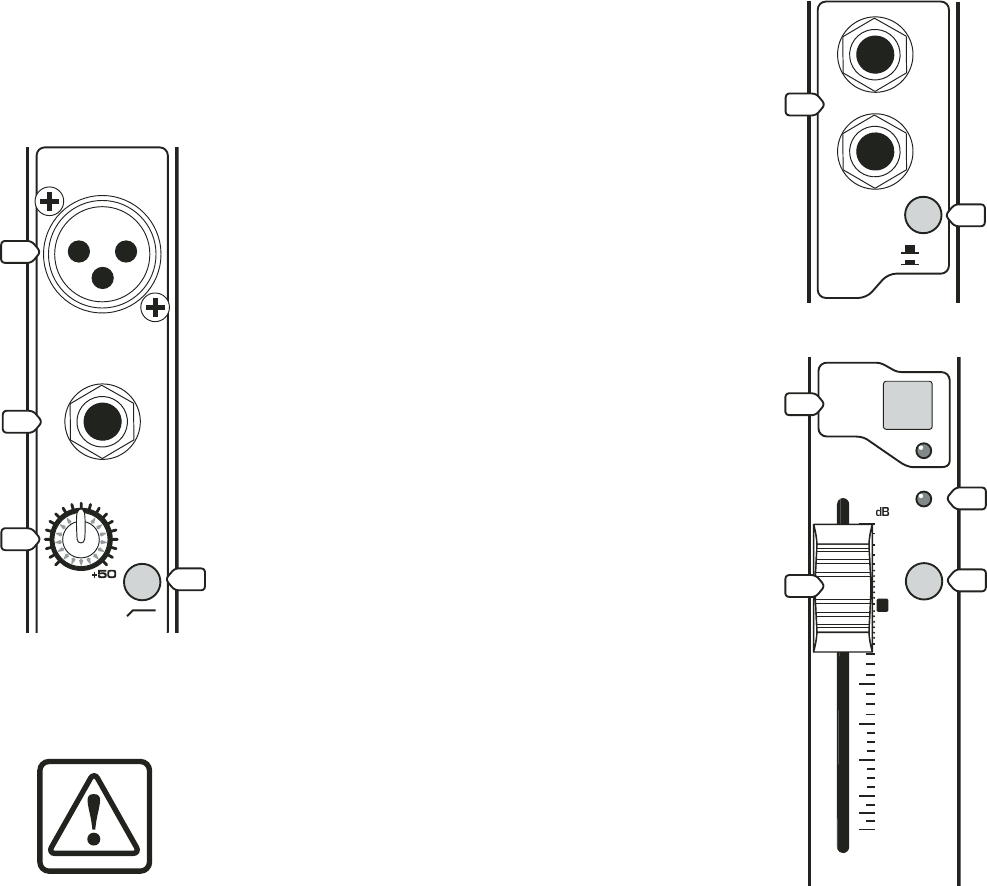
8
MIX FX SERIES FEATURES
CHANNEL INPUTS
1. MIC (MICROPHONE) INPUTS
The MIX FX Series is
equipped with four rugged,
low-noise, phantom-powered
microphone preamplifi ers,
providing up to 50 dB of crys-
tal-clear amplifi cation. Their
balanced circuitry rejects all
manner of extraneous interfer-
ence. Professional condenser,
dynamic, and ribbon mics all
sound excellent through these
XLR inputs.
You can plug in almost any
kind of balanced mic that has
a standard XLR-type male mic
connector. See Appendix B
for more information on XLR
connectors.
The MIX FX Series provides
+48 VDC phantom powering
on pins 2 and 3 of the mono
channels’ XLR MIC inputs. This
can be turned on and off using
the PHANTOM [58] switch.
CAUTION: DO NOT connect a line-
level device to a MIC input with the
phantom power switched on. This
could damage the device. Use the
LINE IN [2] jacks instead.
Do not use phantom power with tube or ribbon
microphones, as this may cause damage.
2. LINE INPUTS
These inputs can accept 1/4" TRS balanced and TS
unbalanced plugs from any line-level instrument, eff ects
device, or tape player. They can be driven by virtually
any line-level signal, from –45 dBu up to +18 dBu.
There are two line-inputs for each stereo channel,
a left and a right. When connecting a stereo device
(two cords), use both the left (mono) input and the
right input.
When connecting a mono device (just one cord),
always use the left (mono) input and plug nothing
into the right input. A trick called “jack normalling”
causes the signal to appear on both sides.
3. GAIN CONTROL
(Mono Channels only)
If you haven’t already, please
read “SET THE LEVELS” on page 4.
The GAIN control adjusts the
input sensitivity of the MIC and
LINE inputs. This allows signals
from the outside world to be
adjusted to optimal internal
operating levels.
The GAIN control provides
50 dB of gain with the knob
fully up.
4. +4/–10 Switch
(Stereo channels only)
Instead of a rotary gain
control, the stereo channels
have a gain switch. This
changes the input sensitivity
of the channel to match either
the –10 dBv consumer level or
the +4 dBu professional level.
Most consumer equipment with
RCA connectors operate at
the –10 dBv level, while most
professional equipment with
1/4-inch phone jacks or XLR
connectors operate at the +4
dBu level.
As you might expect, the
+4 dBu level is higher (louder)
than the –10 dBv level. If you
have trouble getting enough volume from a signal
connected to one of these stereo channels, push in
the +4/–10 switch to get more volume.
5. OL LED
This handy LED (Light Emitting Diode) lets you
know that the signals going into the mixer are
adjusted to the correct level, not too strong
to cause
distortion and not too weak to be lost in noise.
After you connect a microphone or line-level
component to the mixer, do a sound test and adjust
the GAIN control until this handy LED fl ickers just
occasionally. If it is glowing constantly, turn the GAIN
down. If the LED is doing almost nothing, turn it up.
Mix.220FX Mono Channel
OL
SOLO
PRE
MON
FX
SEND
MIC
INPUT
INPUT
11
LINE
BAL/UNBAL
BAL/UNBAL
GAIN
75H
75H
z
0
+15-15
U
+15-15
U
+15-15
U
2.5kHz
12kHz
80Hz
+15
U
+15
U
RL
U
OO
30
20
10
40
50
5
5
60
10
1
3
6
2
OL
OL
SOLO
SOLO
PRE
ALT
3/4
MON
FX
SEND
L
R
(MONO)
BAL
OR
UNBAL
+4
-10
5
6
MUTEMUTE
+15-15
U
+15-15
U
+15-15
U
2.5kHz
12kHz
80Hz
+15
U
+15
U
RL
U
OO
30
30
20
20
10
10
40
40
50
50
5
5
60
60
10
10
16
15
5
17
Mix.220FX Stereo Channel
OL
SOLO
EQ
PRE
MON
FX
SEND
L
R
(MONO
MONO
)
5
6
LINE
BAL
BAL
OR
OR
UNBAL
UNBAL
+4
-10
-10
+15-15
U
+15-15
U
+15-15
U
2.5kHz
12kHz
80Hz
+15
U
+15
U
RL
U
OO
30
20
10
40
50
5
5
60
10
2
4
Mix.220FX Stereo Channel


















